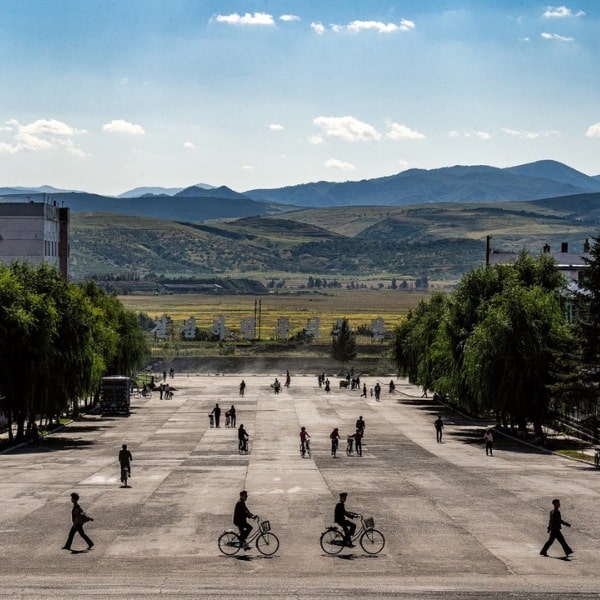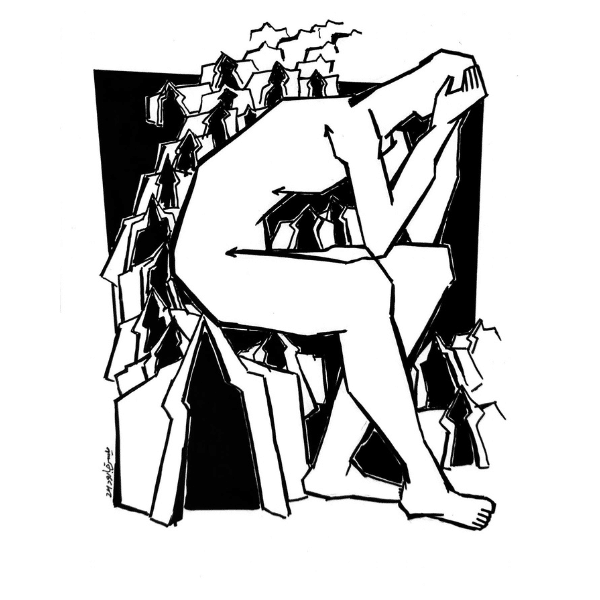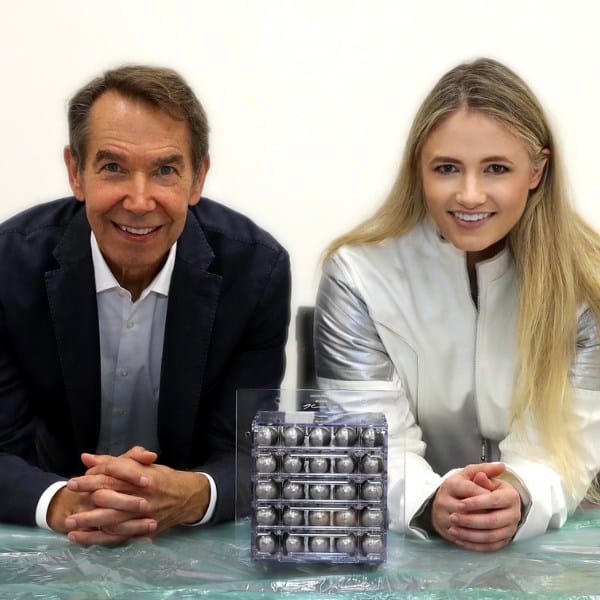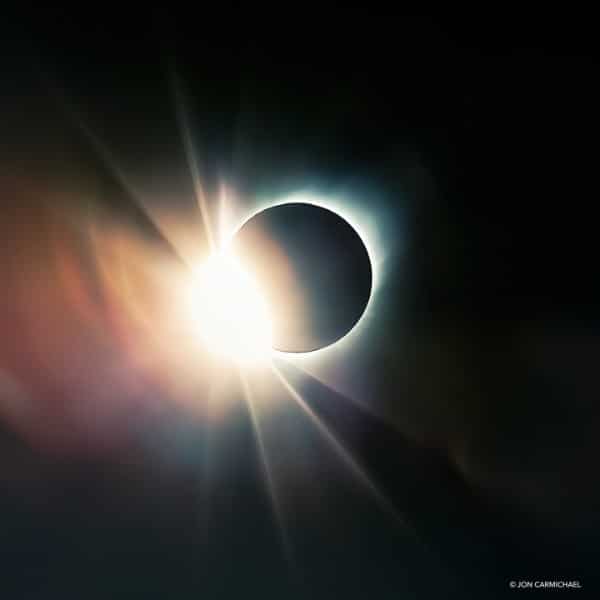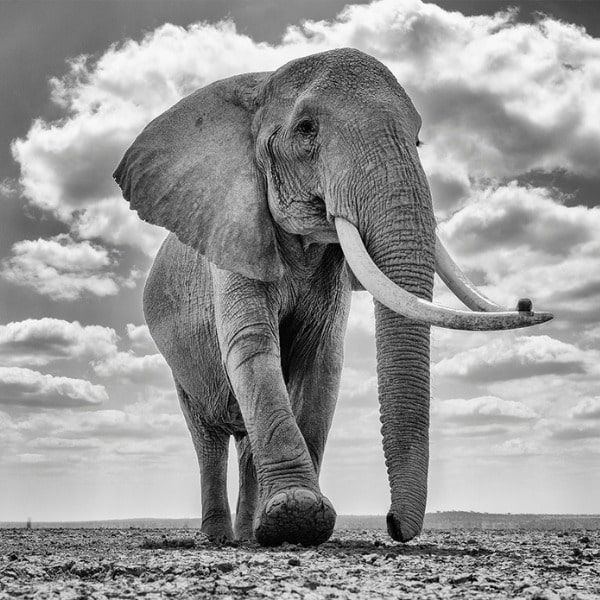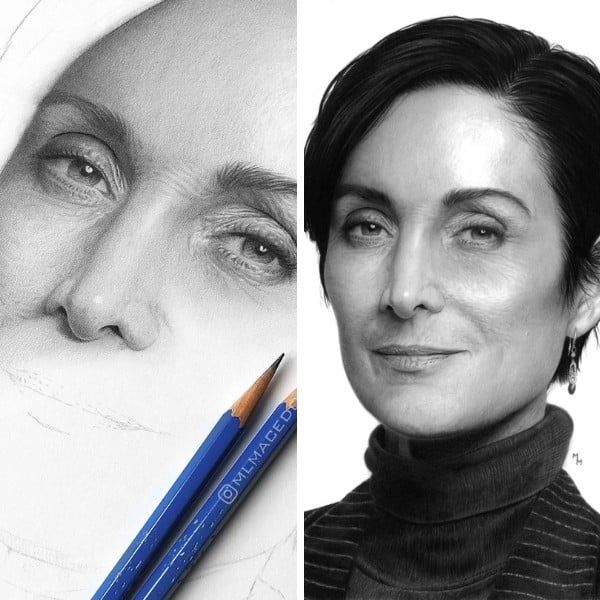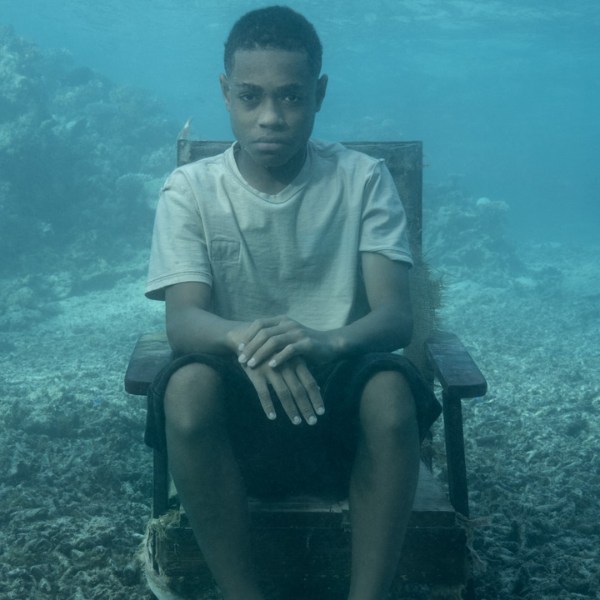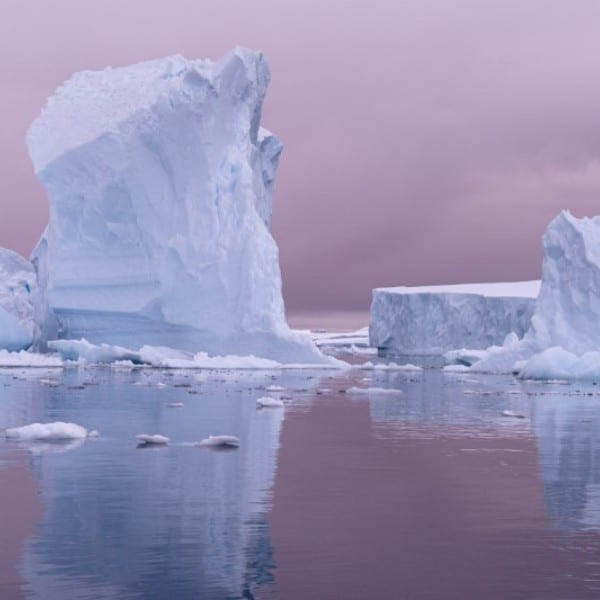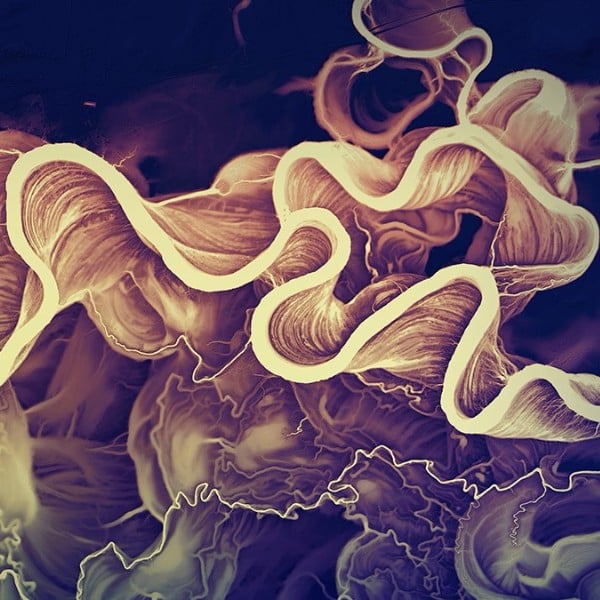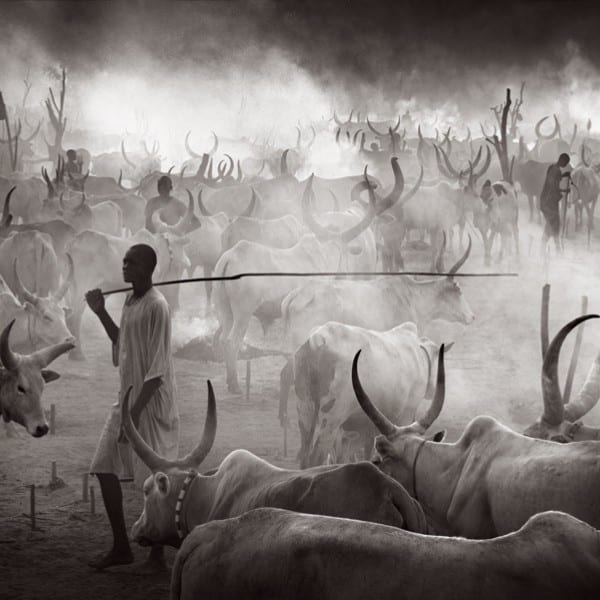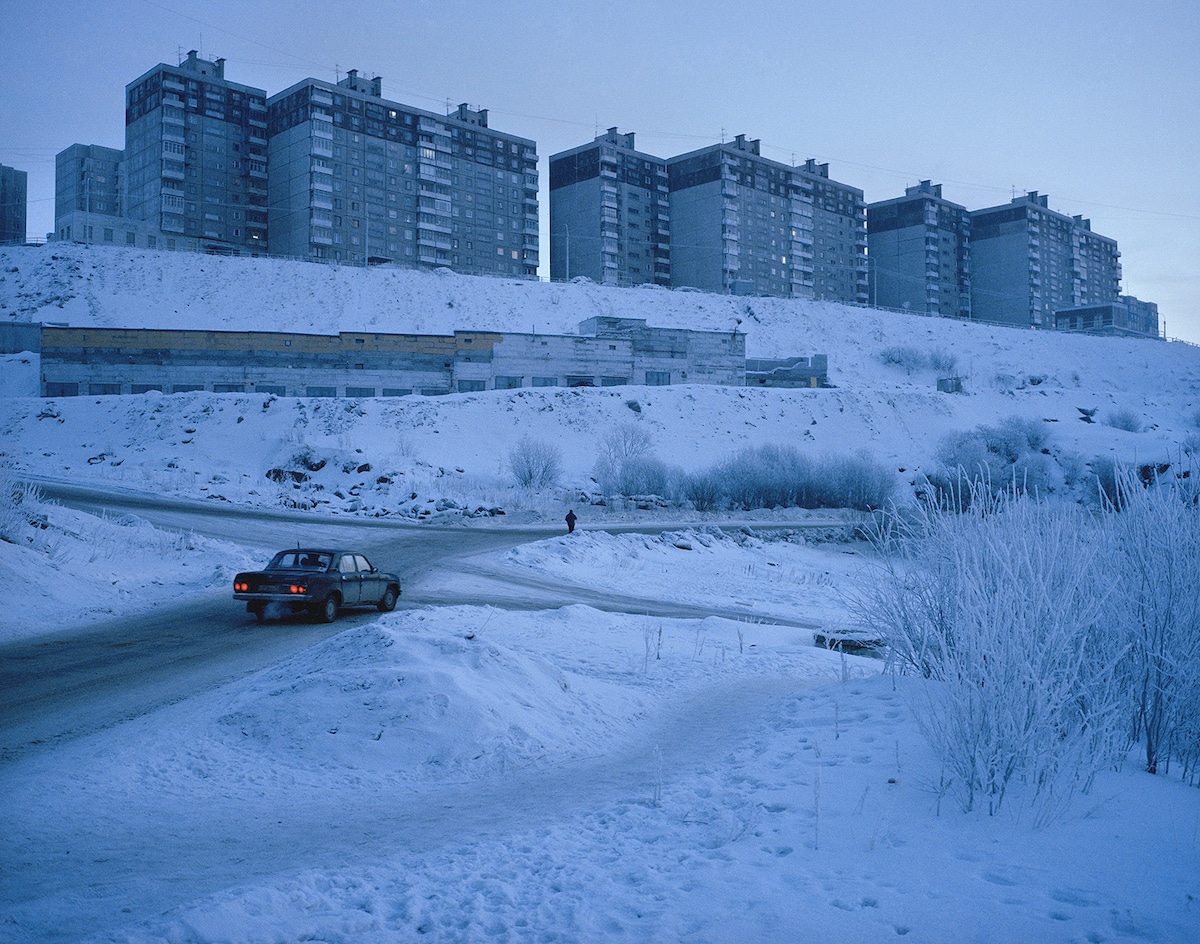
Untitled 3, Murmansk, Russia, January 2005.
A car and pedestrian walk in a residential suburb of Murmansk.
Fifteen years ago, photographer Simon Roberts spent a long, cold winter in Russia's unforgiving far North. It's a place where, from December until mid-January, there are nearly 24 hours of darkness, as the sun sits below the horizon. In this context, Roberts set about documenting life in one of the world's harshest climates. The result is his acclaimed Polyarnye Nochi series.
Translating to “polar nights,” Polyarnye Nochi is a thrilling look at this desolate part of the world. As temperatures dropped and people bundled up indoors, Roberts plunged into the darkness. Using a medium format camera—the temperatures made digital photography impractical—he roamed the cities and towns around Kola Bay, ducking inside for warmth every so often.
Bathed in blue and grey, his photographs are a haunting look at a land covered in ice and snow. Nearly devoid of human activity, the landscapes are the protagonists here—big and overbearing. Their looming presence makes it clear that, here, nature dominates; and if you want to survive, you need to adapt.
We had a chance to speak with Roberts about the landmark set of photos, as well as his love for Russia and what it felt like to pass months without seeing the sun. Read on for My Modern Met’s exclusive interview.
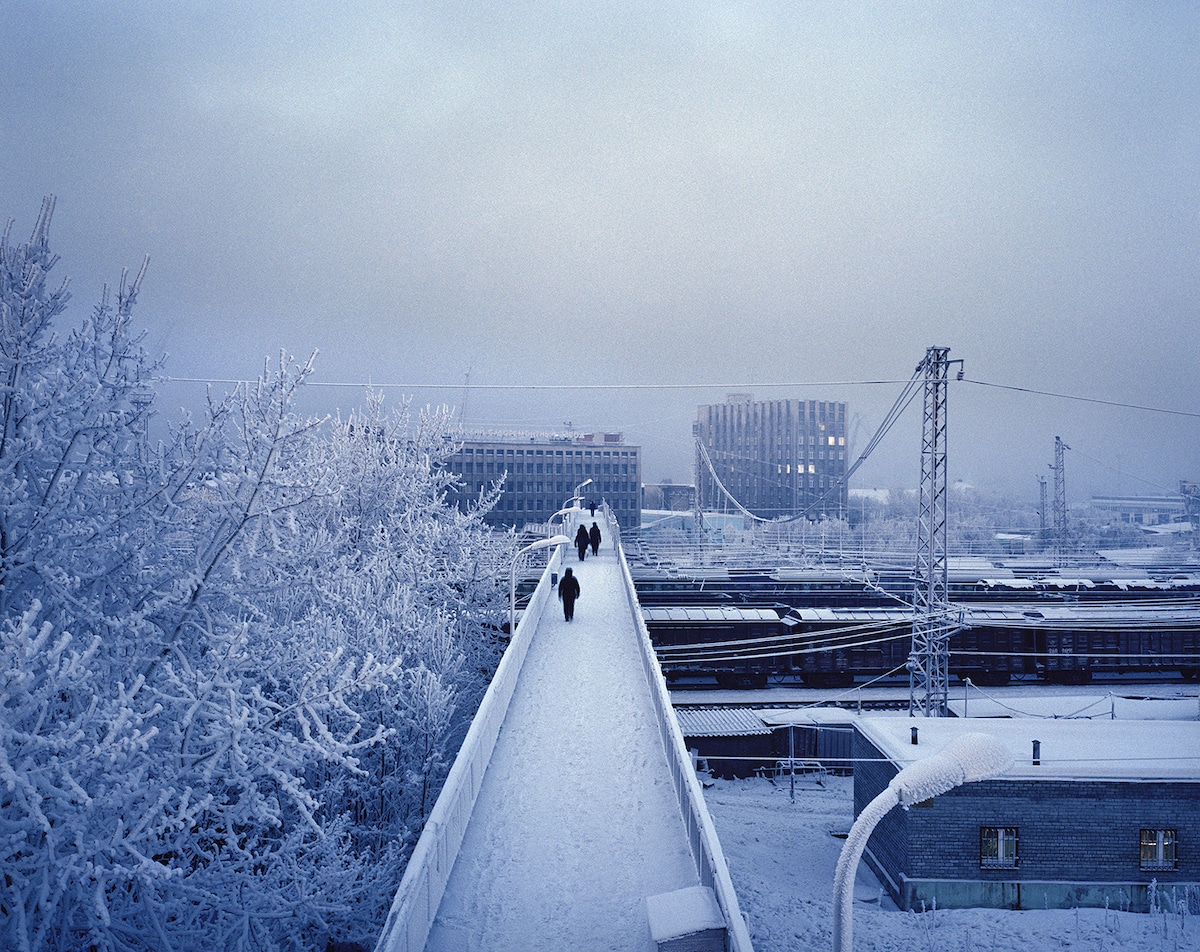
Untitled 8, Murmansk, Russia, January 2005
Pedestrians walk on a footbridge over Murmansk's freight railyard. The railway is used to remove radioactive waste products, shipping them to local processing facilities.
What first started your fascination with Russia as a photographer?
Russia has always fascinated me. As a child, it seemed vast and mysterious; taking-up most of the wall map in my geography classroom and being a vital region to capture to win the board game Risk!
However, it was after meeting my wife, Sarah, at university who was studying Russian language and spending time in Russia during her gap-year in the mid-1990s, that whet my appetite. Whilst there had been several important photo documentaries on Russia in the preceding decade after the fall of the Soviet Union, these tended to focus on collapse and deterioration—with their emphasis on the consequences of Russia’s turbulent past as opposed to the possibilities of its future.
In 2004, Sarah and I decided to return and spend a year crisscrossing this vast nation. Motherland—the resulting book—is meant as a visual statement about contemporary Russia, fifteen years after the fall of Communism.
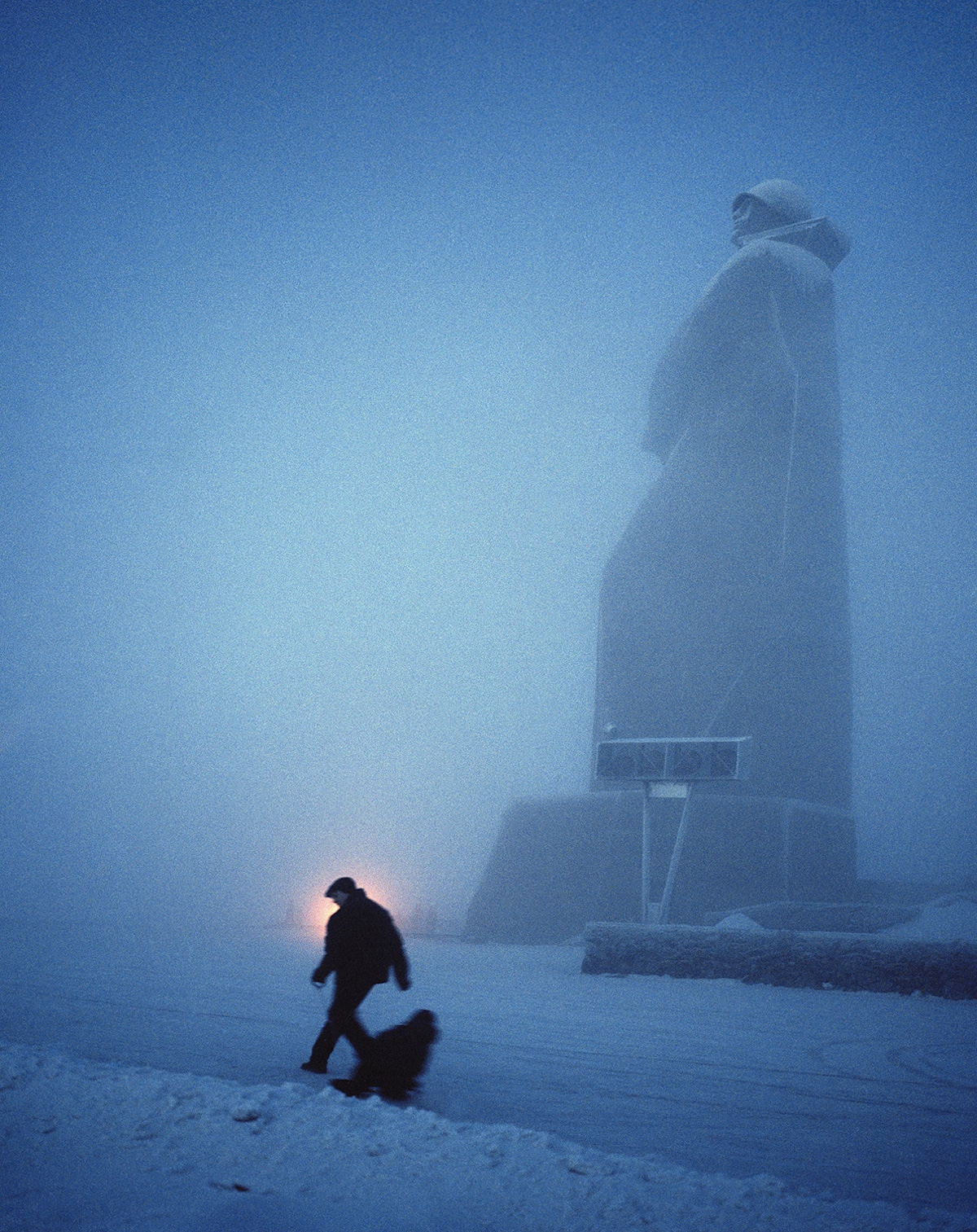
Untitled 11, Murmansk, Russia, January 2005
A man pulls a child on a sled past the statue of a soldier, known as Alyosha, built on a hill overlooking Murmansk to commemorate the ‘Defenders of the Arctic’ during World War II. The statue faces westward, towards the port and is visible from most parts of Murmansk, standing as he does on an elevated plateau above Lake Semyonovskoe and being an immense thirty-four meters high himself. He’s a soldier carved of granite, his caped cloak, tin hat, and hands, which clasp the strap of the rifle slung over his back are roughly hewn from the same stone, immoveable and severe. Alyosha has stood guard over Murmansk only since 1974, erected to commemorate Murmansk’s status as a ‘hero city’ during the Second World War when the city inhabitants defended themselves against German bombardments even while three-quarters of their town was razed to the ground.
Motherland was such a huge success. Did the idea of Polyarnye Nochi come about at the same time?
No, it was only after traveling to Russia’s arctic periphery during winter–where these photographs were taken–that I decided to create a specific series on this unique meteorological phenomenon known as Polyarnye Nochi (Polar Nights). A period of perpetual darkness, it occurs only inside the polar circles between December and mid-January when the sun remains below the horizon.
During this time one experiences a haunting twilight which can last several hours in the middle of the day. This is often called the “Blue Hour,” when the residual light is reflected off the blue sea and the white snow and the landscape is bathed in a glassy deep blue color. As soon as I started photographing in the region, I knew it would become a series of work in its own right.
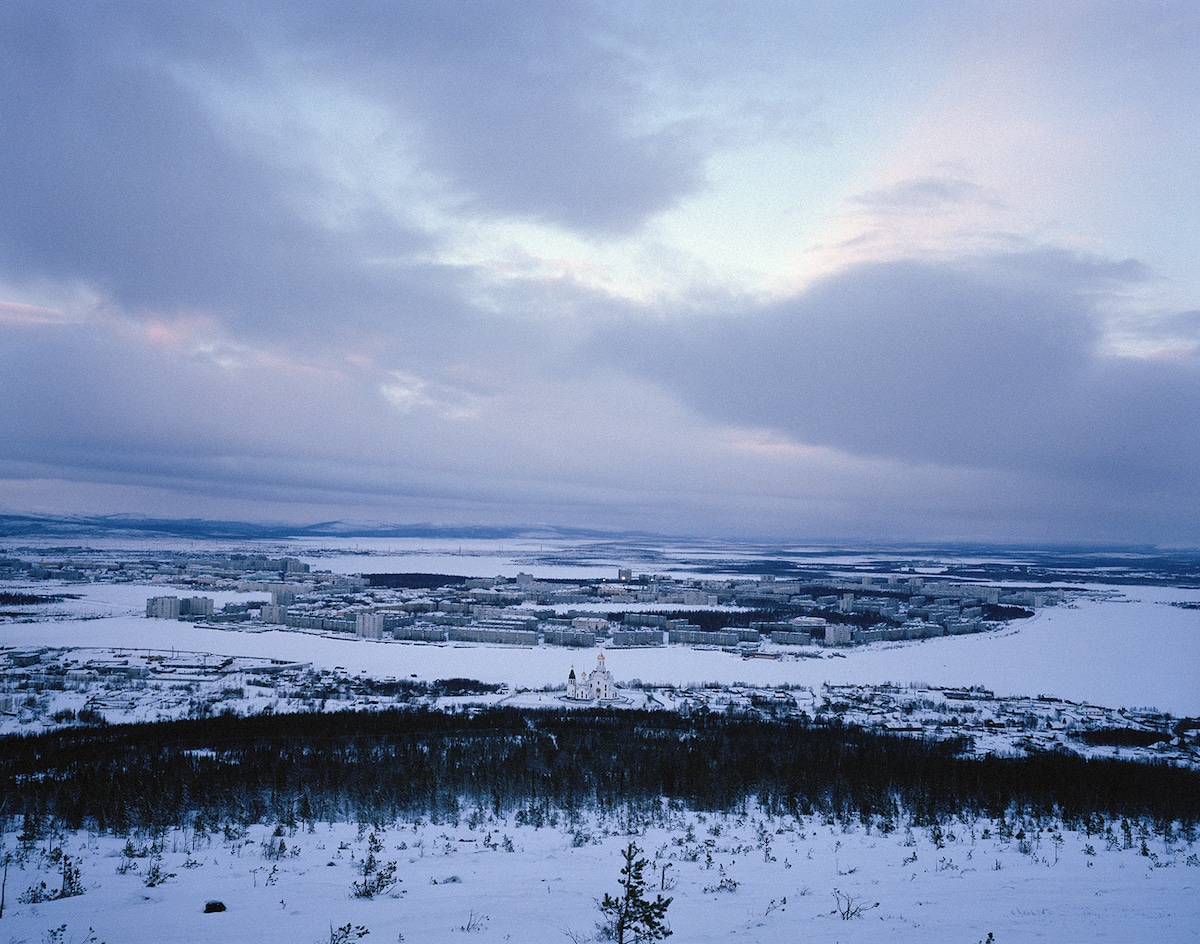
Untitled 24, Monchegorsk, Russia, January 2005
A recently built Russian Orthodox Church stands on the outskirts of the city.
What was it about the concept of continual winter darkness that intrigued you?
Unforgiving and dramatic winters have often been regarded as one of Russia’s most defining characteristics. A Russian winter is redolent both of great hardship—extreme temperatures, physical privation, an atmosphere of isolation and desolation—but also great beauty. As the country’s 19th-century national poet Alexander Pushkin wrote in the first line of a couplet that every Russian schoolchild knows by heart: “Frost and sunshine: a day of wonder.”
Russia’s majesty is heightened by the intensity of its winter and for centuries, the Russian winter has been romanticized by many artists from the master Realists of the nineteenth century to modern-day film directors such as Tarkovsky. Before leaving for the Kola Peninsula, I watched a new film by Andrei Zviagintsev called The Return, which was infused with an inky-blue hue. There’s no doubt that Zviagintsev’s cinematic effect proved influential for my resulting Polyarnye Nochi photographs.
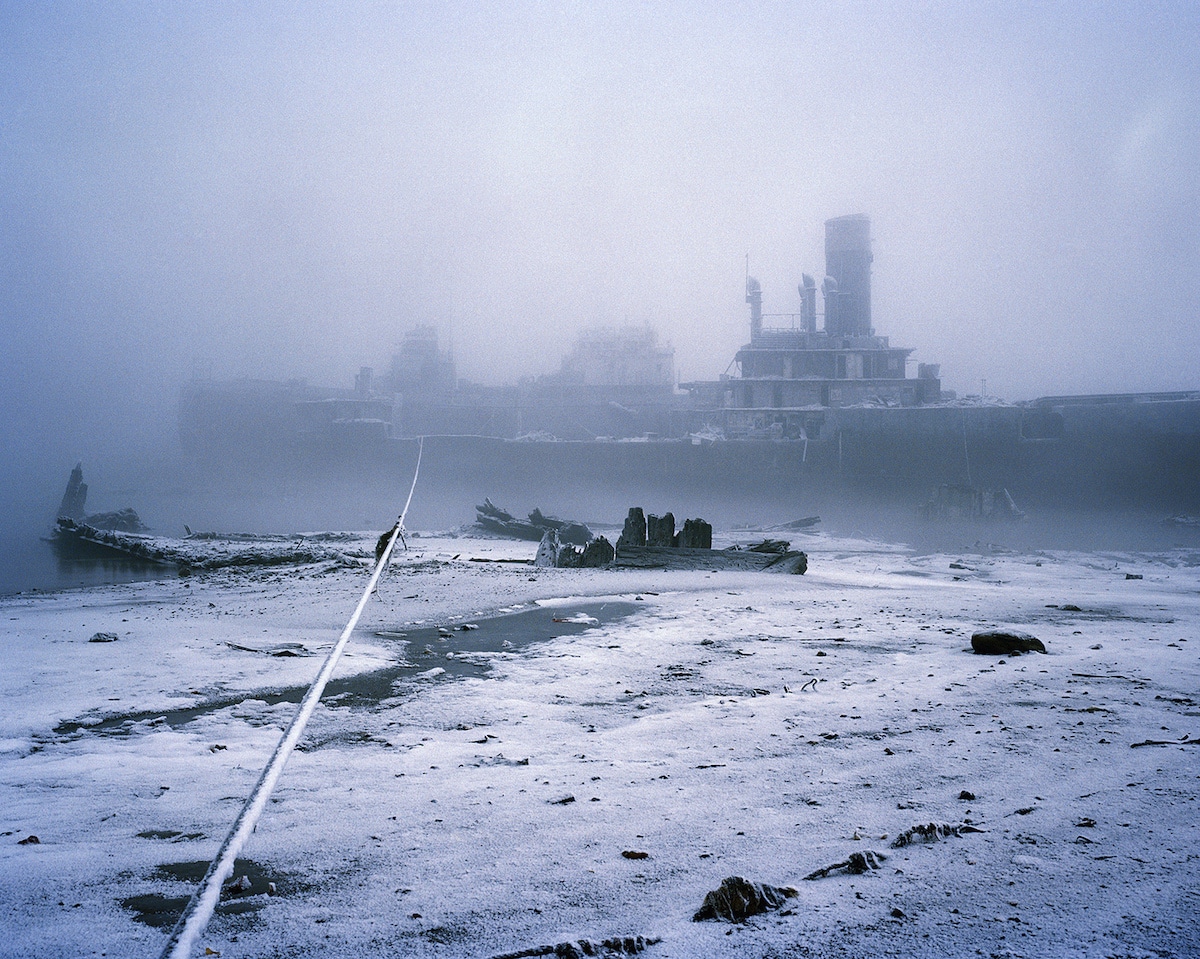
Untitled 9, Kola Bay, Russia, January 2005
An abandoned ship in the Barents Sea.
What effect did the near 24-hour darkness have on you personally?
After a 36-hour train journey from Moscow, the first thing that struck me arriving in Murmansk was the feeling of unreality. The town was shrouded in mist. It rose-up like a mirage, engulfed in a swirling blue fog. Snow and frost weighed down the spindly branches of birch trees and the Soviet apartment blocks looked misleadingly glamorous in the half-darkness—lights burning in windows gleaming their promises of warmth and shelter.
However, it was the temperature that hit me the most—literally. The moment I got off the train it felt like I’d been winded, whilst the icy wind cut into my skin. There was nothing otherworldly about the cold. Russia claims the dubious distinction of being the coldest country in the world. Day after day, the coldest spot on the globe is usually somewhere in Russia. Indeed, the lowest temperature ever recorded outside Antarctica was in a Siberian town of Oymyakon. It was minus 72 degrees. In Murmansk, the average winter temperature is minus 30 degrees, although the severity of the weather conditions is mitigated somewhat by the Gulf Stream, which ensures that this section of the Barents Sea never totally freezes in winter.
I remember walking down to the water on my first morning, hoping to catch a glimpse of one of the many military ships or nuclear icebreakers moored along the coast (the Kola Peninsula’s military significance can be traced back to World War II, when these northern waters became a lifeline for Russia and the Allies). In January though, the Barents Sea seemed not to exist. It was more akin to a billowing, foaming mist that churned around me, so thick it seemed to be tangible. Just offshore, I could hear voices talking loudly through the haze, workers on a boat laboring under the glow of one electric lamp. It was as if the town was determined to remain hidden from me.
Working in such severe temperatures was extremely challenging. I could only remain outside for about thirty minutes at a time before my fingers and toes would lose all feeling and I would need to find refuge in cafés or apartment buildings. The constant darkness makes you feel drowsy all day, but then at night, you can’t fall asleep. It’s as if time is suspended. A 2013 study published by the Russian Academy of Sciences listed the catastrophic effects of “polar health disorder syndrome,” including a range of heart and lung problems, as well as widespread mental and emotional disorders.
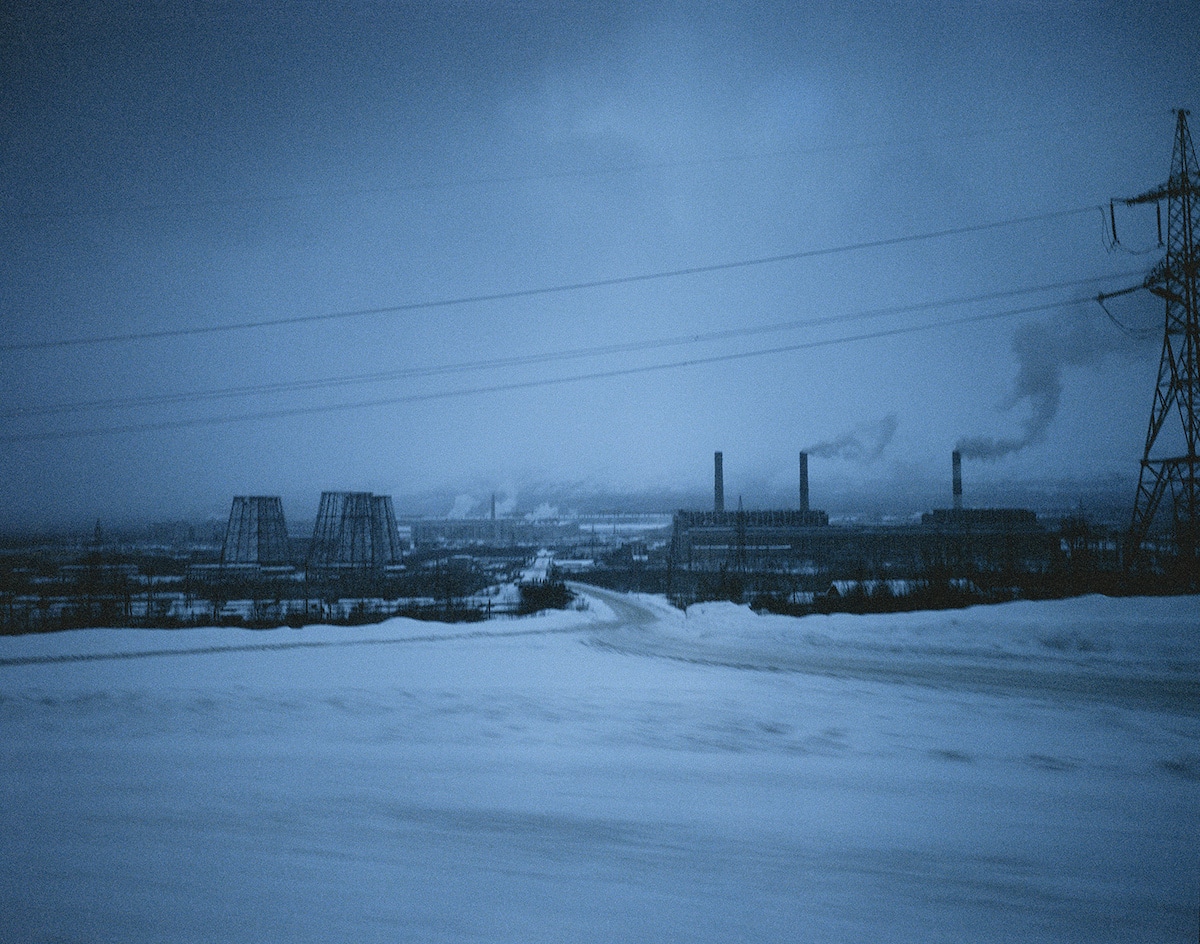
Untitled 6, Apatity, Russia, January 2005
Founded in 1966, Apatity is home to the world's greatest source of apatite ore and is the Kola Peninsula's second-largest city. One of the many industrial sites scattered across the city is pictured from a passing bus window.
How did it shape you, instead, as an artist?
The rigors of the climate and the feeling of intense isolation heightened my senses and I found the experience to be extremely inspiring.
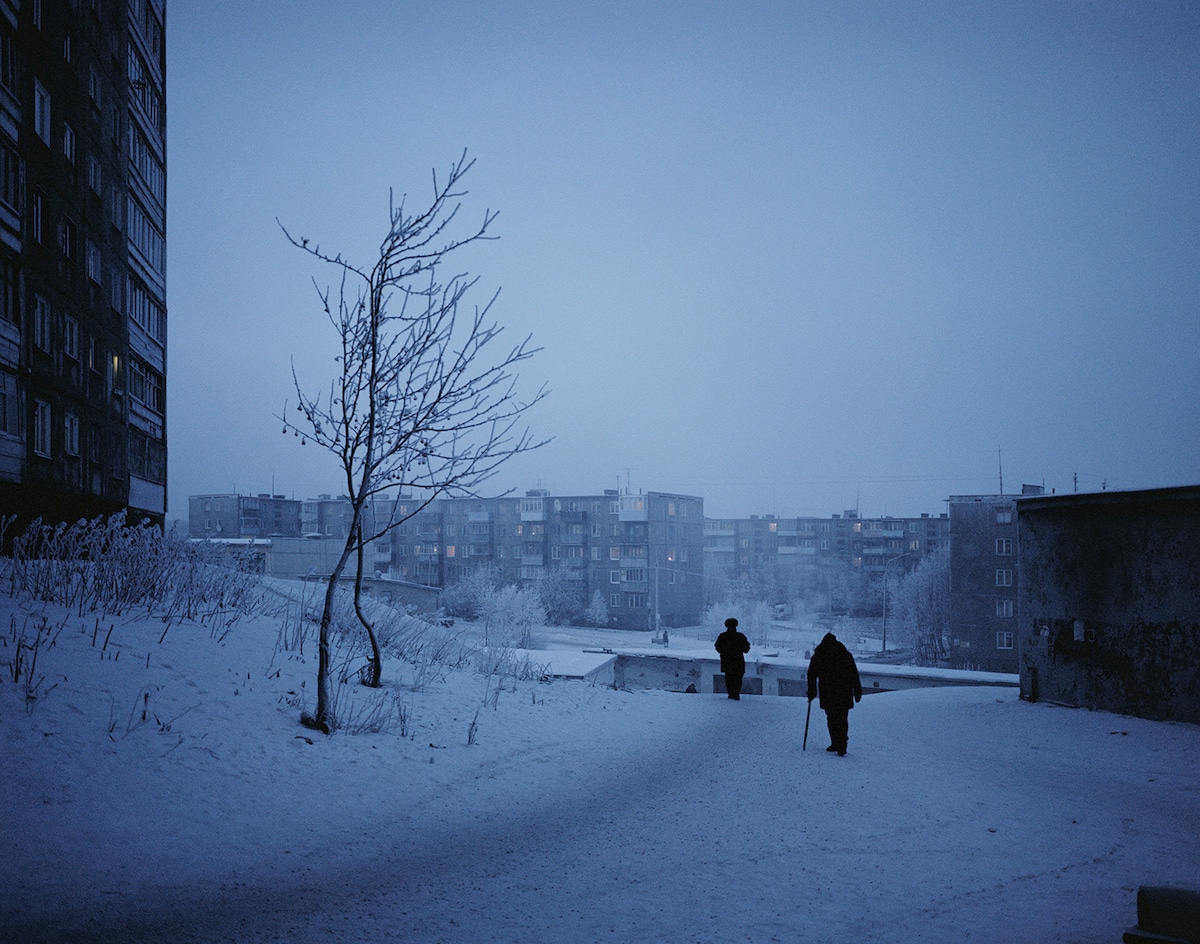
Untitled 1, Murmansk, Russia, January 2005
In mid afternoon, an elderly man walks through a residential area of Murmansk.
People really take a backseat in these compositions. Can you explain that decision?
Practically, it was because there are so few people out on the street during winter; journeys on foot are only made if entirely necessary. On one trolley-bus trip, I made the female conductor cluck with disbelief when she discovered I had been walking the streets. She advised me not to wander around outside in such temperatures “I wouldn’t,” she insisted, “and I’m used to it here.”
The human figures that populate the landscape appear dwarfed not just by nature, but by the very things they have created: a railway, a factory, a warship. I wanted my tableaux-like scenes to convey the immensity and timelessness of the Russian landscape. The people in the photographs are there to make a similar point; anonymous and ant-like, they are dwarfed by their surroundings, silhouetted in the bleak, melancholic beauty of their environment. These hunched forms seem to embody a resilience and an acceptance.
In history, the Russian people personify an endurance that enables them to survive great privation and maintain an eternal hope and optimism despite the—sometimes—harsh reality of daily life in this outpost of the country. So, metaphorically, a sense of the insignificance of human existence in relation to the enormity of nature is evoked at times by my compositions.

Untitled 15, Murmansk, Russia, January 2005
While statistics vary wildly, it is certain that at least a hundred nuclear-powered submarines, some equipped with warheads and nearly all loaded with radioactive materials, are languishing in Murmansk’s harbor. Each one releases its radioactive loads into the sea and air as it deteriorates. Decommissioning the submarines would involve removing reactors, spent fuel and radioactive waste products and shipping them to a processing facility. After reprocessing these materials then need to be contained and placed in long-term storage (where they will be safe, in theory, for tens of thousands of years).
What was the most surprising part of your time there?
It would be the sense of secrecy and paranoia that pervaded the place. This was partly due to the fact that the Kola Peninsula is home to a huge concentration of Russia’s military and nuclear arsenal. The military ports of Severomorsk, Severodvinsk, and Borisglebsk are closed not just to foreigners, but to “non-personnel” Russians as well.
However, one Russian I met, who had lived in Murmansk for twenty-five years, had never ventured the few kilometers to Nikel, a nearby town because it was widely but vaguely described by the local authorities as “off-limits.” When I went to photograph at an old shipyard, my anxious driver warned: “If anyone asks, say that you’re photographing nature, not any of the buildings.”
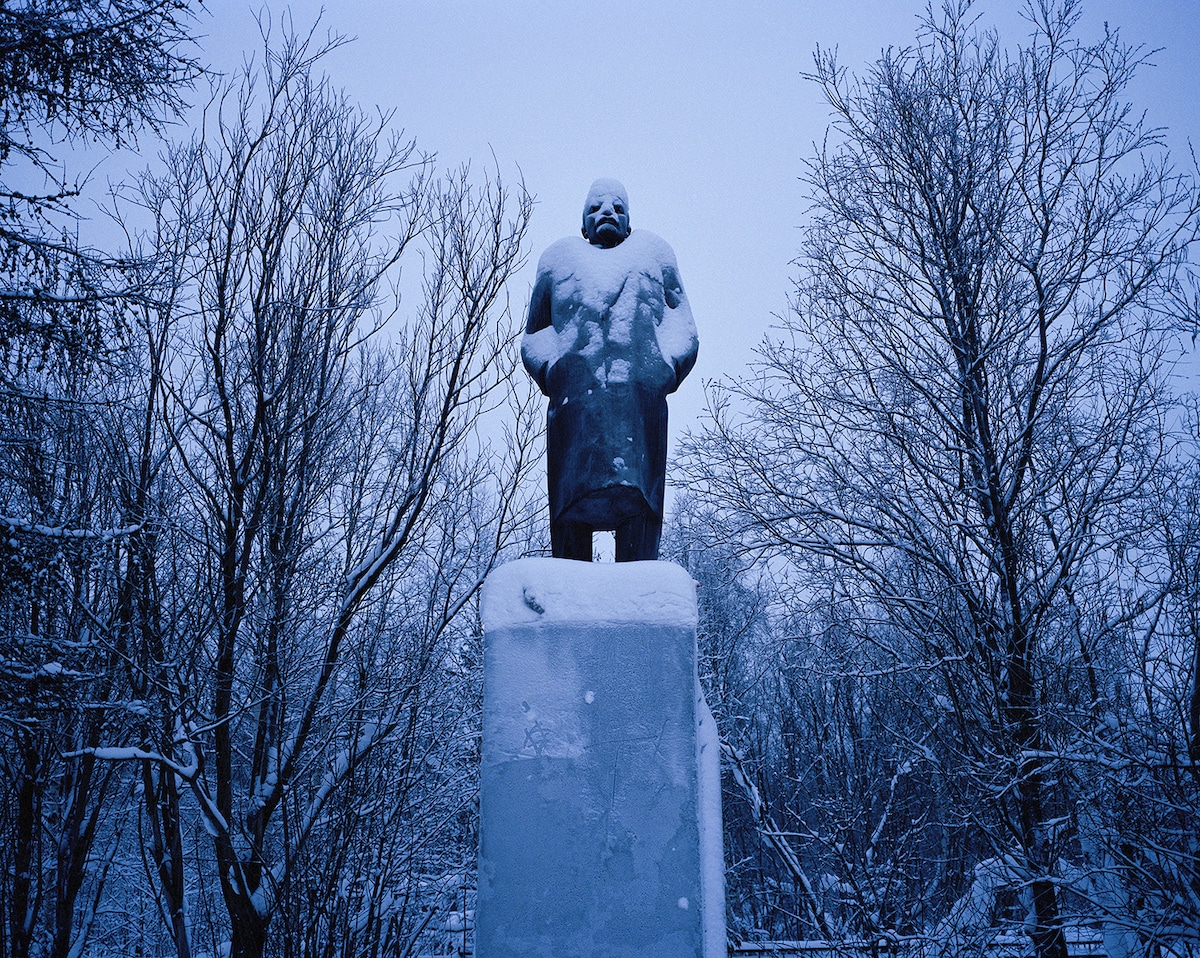
Untitled 12, Apatity, Russia, January 2005
Lenin is a constant presence in most Russian towns, usually presiding over Ploschad Lenina (‘Lenin Square’). In granite, marble, bronze or silver, he comes with a range of personas: the contemplative intellectual, the energetic motivator, the great statesman and the humble proletarian, cap in hand. In Apatity’s Ploschad Lenina, he stands with his hands in his coat pocket, covered with a sprinkling of snow.
It's been quite some time since the series. How do you look back on the experience and the body of work?
It was one of my most memorable experiences, which I think about with great fondness. I liken making the work to being on the ultimate road-movie.
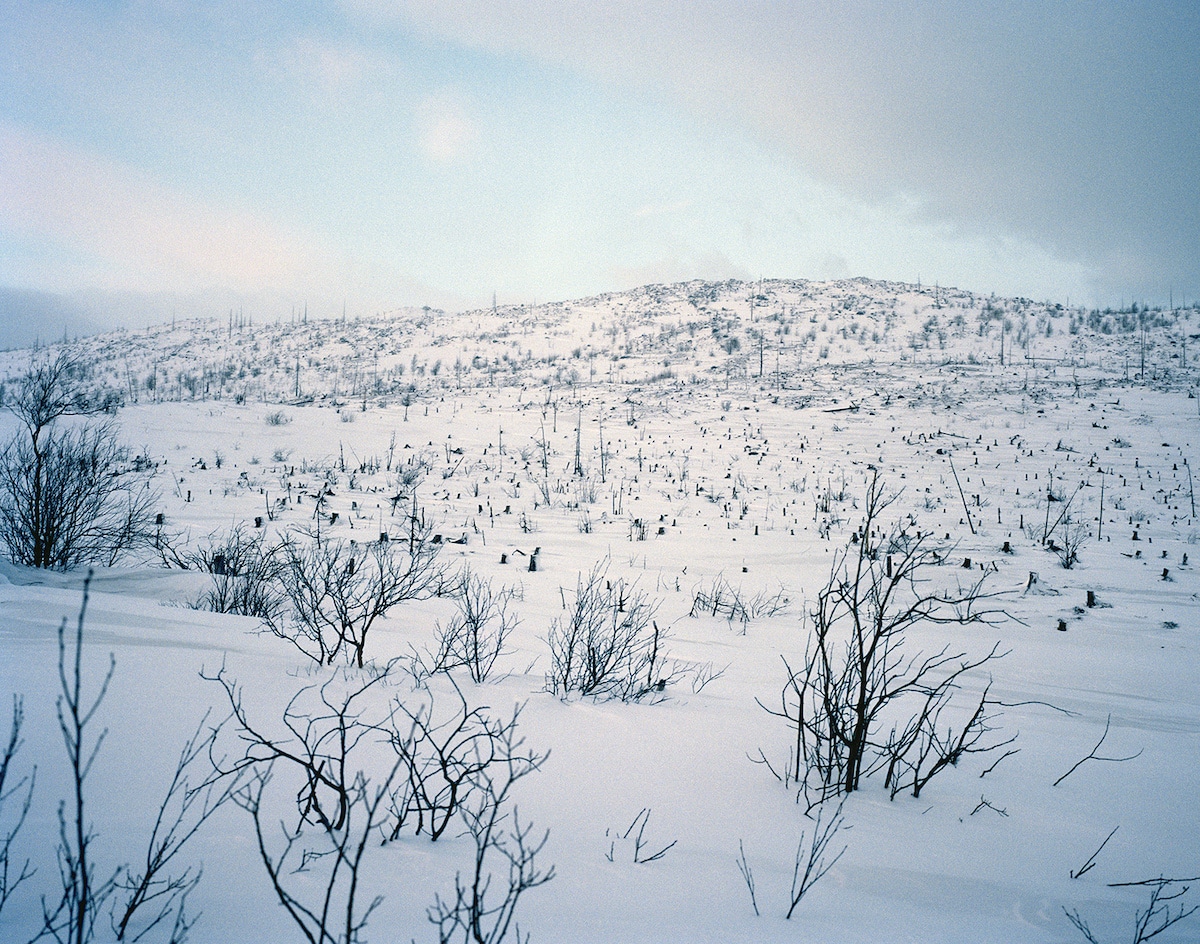
Untitled 20, Monchegorsk, Russia, January 2005
Forests in the vicinity of the Severonikel plant in Monchegorsk have died as a result of contamination by sulfur dioxide and toxic metals emitted by the nickel-copper smelters. It is estimated that the Monchegorsk forest-death area amounts to 40 000-50 000 ha in size.
What do you hope the public takes away from these photos?
Man’s ingenuity in the face of nature’s might is one aspect of these photographs. One-third of Russia’s population live and work in these inhospitable climatic conditions, and I find it extraordinary that factories, apartment blocks, towns, and entire cities have been constructed in what should be a deserted, Arctic wasteland.
However, the photographs are also studies of the way in which nature—and specifically winter (despite being temporarily and often brutally tamed)—can consume, transform, beautify and disguise the man-made world. The photographs hint at the uneasy co-existence of man and nature, but also capture the indefinable and elusive beauty that emerges because of this precarious alliance. The ethereal quality of light; the starkness of a limited palate: an inky sky, white blankness, the black, stencil-like quality of trees, roads or people; the raised perspective—all combine to surprise the viewer with a sense of vastness and grandeur.
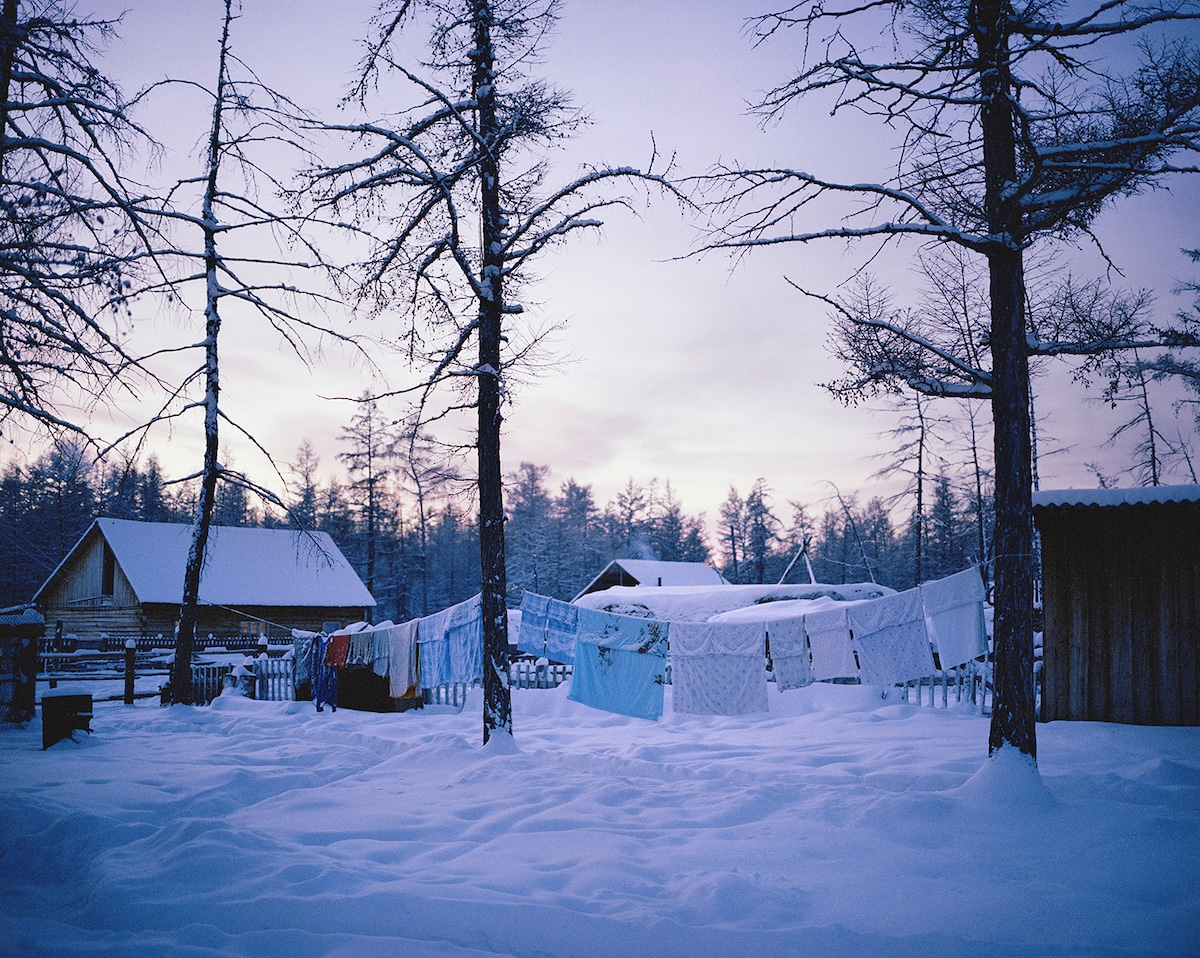
Untitled 13, Magarass, Russia, December 2004
Washing hangs outside traditional wooden homes in this Yakut village of Magarass. The Yakut people arrived in Russia in the 16th century from Turkey. Several tribes still lead semi-nomadic lives, living in yurts and surviving by traditional means – hunting, fishing, raising cattle and herding reindeer.












































































